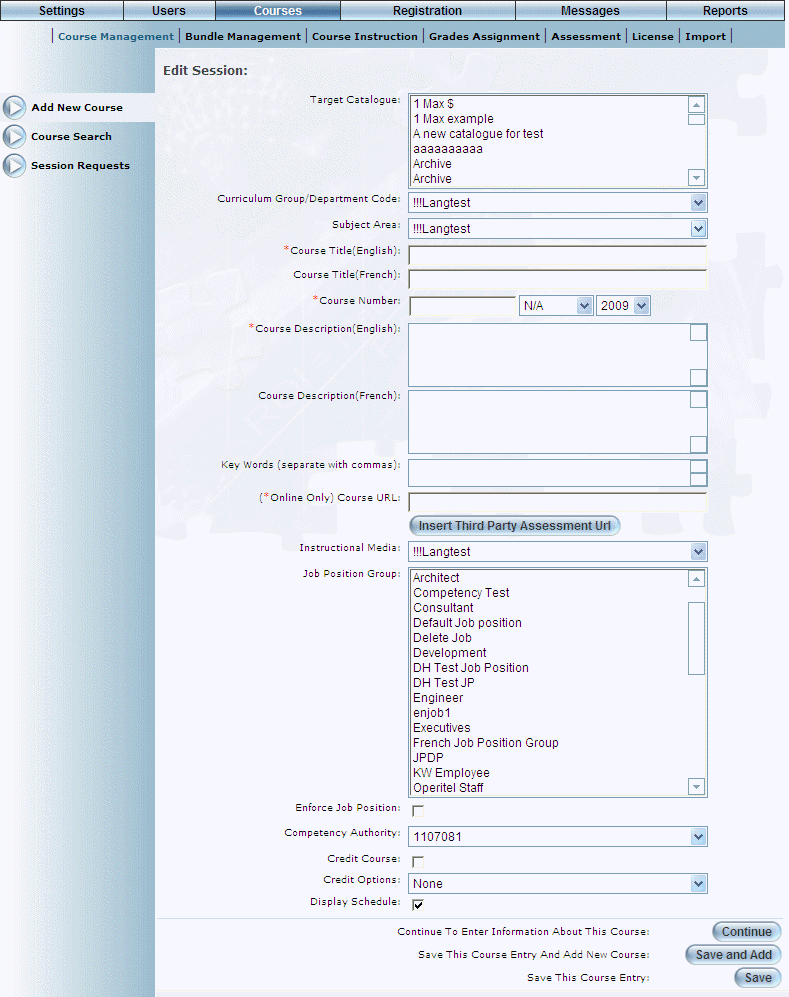
Introduction
Use this section to enter initial information about a course that you are adding.
Note: Some of the values that you specify when adding a course change when editing that course.
Procedure
1. From the Courses menu, select Course Management.
2. Click the Add New Course left-hand side menu.
Note: The Add New Course left-hand side is available when security setting 107: Add New Course is enabled.
The following screen is displayed:

Adding a Course
3. Use the Target Catalogue drop-down list to specify the catalogues to which this course will belong.
Users searching these catalogues will be able to see this course (based on their search criteria).
4. Use the Curriculum Group/Department Code drop-down list to select the curriculum group that you want to associate with this course.
This selection determines the following:
· The course administrators who (through cohorts) can view and manage this course and its related sessions.
· If configured within the curriculum group, the course number.
· If configured, the person defined as the head of the selected curriculum group will receive an email any time a user requests a session of this course.
5. Use the Subject Area drop-down list to specify the subject area of the course.
6. In the Course Title (English) field, enter the name that you want to give to your course.
Optionally, you can enter course titles for other languages if their fields are displayed.
You can specify a maximum of 250 characters (alphanumeric).
Words used in the Course Title field will count as Keywords when searching for courses.
7. In the Course Number field, enter the number you want to give to your course.
You can specify a maximum of 13 characters (alphanumeric).
Note: This field may be displayed when if you selected a curriculum group (done on this screen) that has been configured to auto-generate course numbers. See Adding a Curriculum Group for details.
8. Use the Course Number date drop-down lists to specify the season and year of the course.
9. Use the Course Description (English) box to enter a summary of the course.
This description will be available to students when registering for this course.
Optionally, you can enter course descriptions for other languages if their fields are displayed.
Words used in the Course Description field will count as keywords when searching for courses.
10. In the Key Words field, enter any words that you want to associate with this course.
Whenever a user uses keywords to search for a course on the Advanced Search or Skillsoft Search screen, the associated course will be displayed in the search results.
Note: You can enter multiple keywords as long as they are separated by commas.
11. In the Course URL field, enter the URL for this course.
This value is used for online and external URL courses only. This field will be filled in automatically for an online course. For an external URL course, you need enter its URL.
Note: This field is displayed only when the LearnFlex mode (global setting) has been set to LMS. Contact your LearnFlex representative for details.
12. Click the Insert Third Party Assessment URL button to replace the course's URL with the custom URL specified in the Content Manager - Third Party Assessment URL global setting.
You will be asked to confirm the operation.
Note: This button is displayed when two items are configured: 1) LearnFlex mode (global setting) is set to LMS. Contact your LearnFlex representative for details, and 2) Security setting 681: 3rd Party Assessment URL has been enabled.
For information about specifying the Third Party Assessment URL global setting, contact your LearnFlex representative.
13. Use the Instructional Media drop-down list to indicate how courses move from the learning plan to the achievement record.
These are defined in the Instructional Media module.
Note: This field is displayed only when the LearnFlex mode (global setting) has been set to LMS. Contact your LearnFlex representative for details.
14. Use the Job Position list box to specify those job positions whose users can see this course.
You can add or edit job position groups in the Job Position Groups module.
15. Check the Enforce Job Position box to indicate that only those users in the job position groups selected above can see and register in this course.
Checking this box also means administrators will be prevented from registering any user with a job position conflict (no job positions of the user match any job position specified for the course) during group registration of this course.
Hint: You can choose to ignore job position conflicts.
16. Use the Competency Authority drop-down list to specify the group that can administer the course, and is responsible for training.
The competency selected here will be displayed on this course’s competency map, which allows you to indicate that completing this course can also automatically complete selected competencies (within this competency authority). You can add or edit job position groups in the Competency Authority module.
17. Check the Credit Course box to indicate that this course is considered a credit course.
18. Use the Credit Options drop-down list to specify credit options for the course.
The values in this list are managed through the Credit Options module. See Managing Credit Options for details.
19. Check the Display Schedule box to indicate if the course schedule should be displayed.
20. You can perform the following operations from this screen:
· Click Continue to proceed with entering additional details about this course. This screen will be called Course Basics, and additional left-hand side menus will be displayed. You will continue to the Course Additional screen.
· Click Save and Add to save the course as a new one.
· Click Save to keep your changes.